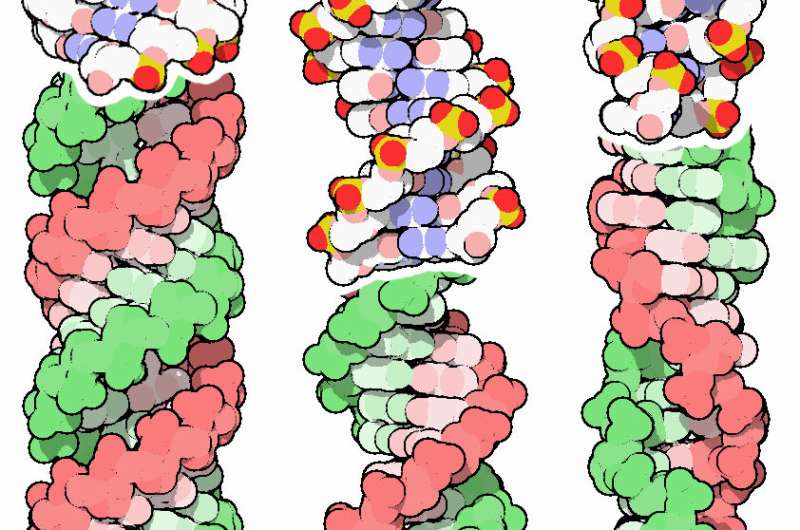Three conformations of the DNA double helix: A (left), B (center) and left-handed Z (right). Credit: David S. Goodsell and RCSB PDB
Darwin's theory of evolution should be expanded to include consideration of a DNA stability "energy code"—so-called "molecular Darwinism"—to further account for the long-term survival of species' characteristics on Earth, according to Rutgers scientists.
The iconic genetic code can be viewed as an "energy code" that evolved by following the laws of thermodynamics (flow of energy), causing its evolution to culminate in a nearly singular code for all living species, according to the Rutgers co-authored study in the journal Quarterly Reviews of Biophysics.
"These revelations matter because they provide entirely new ways of analyzing the human genome and the genome of any living species, the blueprints of life," said senior author Kenneth J. Breslauer, Linus C. Pauling Distinguished University Professor in the Department of Chemistry and Chemical Biology in the School of Arts and Sciences at Rutgers University-New Brunswick. He is also affiliated with the Rutgers Cancer Institute of New Jersey. "The origins of the evolution of the DNA genetic code and the evolution of all living species are embedded in the different energy profiles of their molecular DNA blueprints. Under the influence of the laws of thermodynamics, this energy code evolved, out of an astronomical number of alternative possibilities, into a nearly singular code across all living species."
Scientists investigated this so-called "universal enigma," probing the origins of the astounding observation that the genetic code evolved into a nearly uniform blueprint that arose from trillions of possibilities.
The scientists expanded the underpinnings of the landmark "survival of the fittest" Darwinian evolutionary theory to include "molecular Darwinism." Darwin's revolutionary theory is based on the generational persistence of a species' physical features that allow it to survive in a given environment through "natural selection." Molecular Darwinism refers to physical characteristics that persist through generations because the regions of the molecular DNA that code for those traits are unusually stable.
Different DNA regions can exhibit differential energy signatures that may favor physical structures in organisms that enable specific biological functions, Breslauer said.
Next steps include recasting and mapping the human genome chemical sequence into an "energy genome," so DNA regions with different energy stabilities can be correlated with physical structures and biological functions. That would enable better selection of DNA targets for molecular-based therapeutics.
More information: Horst H. Klump et al, Energy mapping of the genetic code and genomic domains: implications for code evolution and molecular Darwinism, Quarterly Reviews of Biophysics (2020). DOI: 10.1017/S0033583520000098
Provided by Rutgers University
























